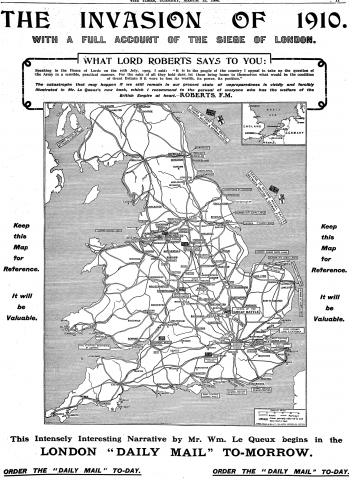
In September 1909, rather late in Invasion‘s run, an article appeared in Pearson’s Weekly explaining not only some of the pyrotechnical mechanics behind the spectacle, but also the underlying airpower theory. Because it was not merely an popular entertainment and a commercial one at that, but a response to the question ‘Invasion by aeroplane, is it possible?'((Pearson’s Weekly (London), 9 September 1909, 204.))
First, the scene was set. The spectators were on one side of the Crystal Palace football ground, and opposite was ‘a magnificent set scene, one thousand feet in length, depicting a typical, peaceful English village’.((Ibid.)) The peaceful ‘villagers, including Territorials, millers’ men, and village maidens […] seen disporting themselves on the green sward’ were there to show that ‘an airship invasion would be sudden and unexpected’.((Ibid.))
At a given signal, Mr. Brock’s assistants, who are posted on the heights above the football ground inclosure, send off a number of dirigible balloons, and these as they rise in the air guide themselves right over the village. Each balloon is loaded with fireworks which are ignited by time fuses, and as the explosives drop off automatically and burst over the village below, one would actually think that gunners were firing them from the balloons above.((Ibid.))
As well as airships, there were aeroplanes ‘moored to poles at the outskirts of the football ground […] these too are released and glide straight for the doomed village, at which they also discharge explosives’.((Ibid.)) They also carry the invasion force, however: one ‘piece of excellent stage management’ involves ‘an immense aeroplane, filled out with men dressed as foreign soldiers, which glides out from one of the wings as though swooping into a favourable position on the village green’.((Ibid.))
Certainly there was some clever stagecraft going on:
portions of the village seem to collapse before the relentless bombardment. The church, for example is cleverly blown up. Only the rafters remain, and as brilliant twinkling fires are brought to bear on these, they seem actually to be on fire.((Ibid.))
Of course, it wasn’t actually on fire, since they had to reset the whole set-piece and do it all over again in the next evening’s performance. There were over two hundred performers to wrangle, and each performance was said to cost £250. Even allowing for hyberbole, it does sound like an impressive spectacle:
Up above the air seems to be on fire with the innumerable brilliant stars of the rockets and the explosives that drop from the soaring balloons. On the ground beneath, the gigantic village scene, played upon by the gleam of the pyrotechnic flares, seems also given over to the flames; while the explosions of the fireworks and the terrible rattle of the musketry as the invaders and villagers fire at each other, add an effect which makes the whole seem both terrible and awe-inspiring.((Ibid.))
But it wasn’t just spectacle, and this is where the airpower thinking comes in, since ‘the village Territorials are formed up and fire volleys of specially prepared rockets on the [dirigible] balloons above’:
Some of the shells thus launched into the air weigh anything up to two hundredweight each, and when they explode they throw out thousands of balls of fire […] A balloon amid that zone of brilliant sparks runs every chance of being rendered hors-de-combat, while the manner in which the exploding rockets illuminate the heavens enables the marksmen below to locate the enemy((Ibid.))
These firework rockets weren’t presented as a panacea, as it is said that they would be ‘practically powerless against the aeroplanes’ for which a ‘specially designed’ mobile artillery piece is put forward, one which can be tilted almost perpendicular and which has wheels which can be turned inwards for use quickly in rotating the gun. This was an attempt at thinking the air defence problem through, so this isn’t simply a case of having a hammer and looking for a suitable nail — though the hammer was indeed to hand.
The article was based on an interview with Arthur Brock who had already written an article called ‘Fireworks versus flying machines’ for Pearson’s in January 1909 making exactly the same case, so well before Invasion was mounted — before the airship panic, in fact, perhaps inspired by the publicity of the founding of the Aerial League of the British Empire.((Pearson’s Weekly (London), 28 January 1909, 615.)) Brock was ‘the King’s Pyrotechnist’ and head of the eponymous fireworks manufacturer (est. 1698); and his son, Frank Brock, developed the famous incendiary ammunition which was a key factor in overcoming the Zeppelin threat from 1916 onwards. So there was a connection of sorts here between aerial theatre about air defence and actual air defence.
Image source: Pearson’s Weekly (London), 28 January 1909, 615.1
![]() This work is licensed under a Creative Commons Attribution-NonCommercial-NoDerivatives 4.0 International License.
Permissions beyond the scope of this license may be available at http://airminded.org/copyright/.
This work is licensed under a Creative Commons Attribution-NonCommercial-NoDerivatives 4.0 International License.
Permissions beyond the scope of this license may be available at http://airminded.org/copyright/.
- See also the garishly full-colour Brock poster for an aerial-themed show said to date to 1908, though I’m pretty it sure it’s for Invasion and from 1909. See Harry Smee and Henry Macrory, Gunpowder and Glory: The Explosive Life of Frank Brock OBE (Oxford: Casemate, 2020), who date it to 1909, even though they’re also responsible for the 1908 claim. [↩]



